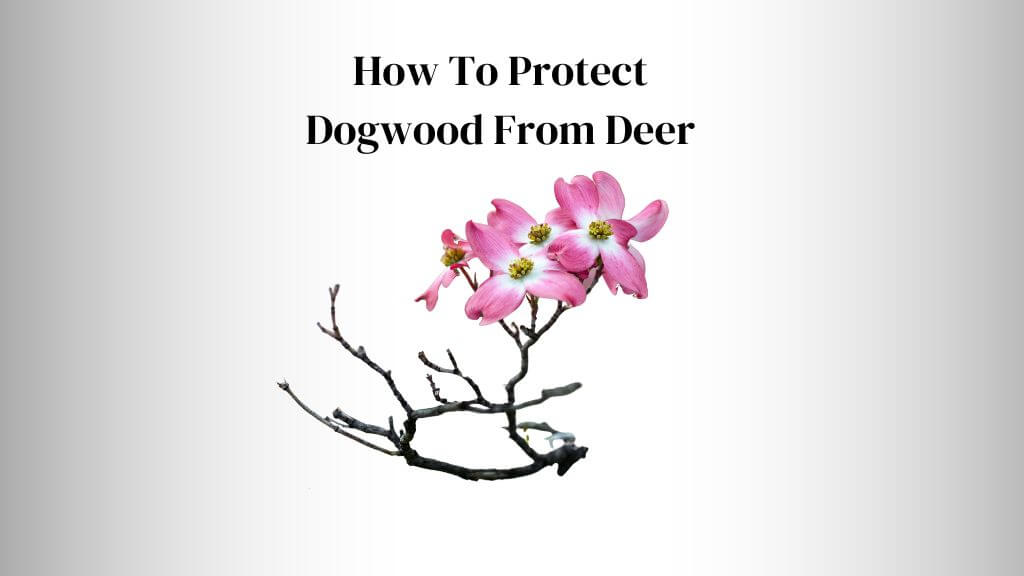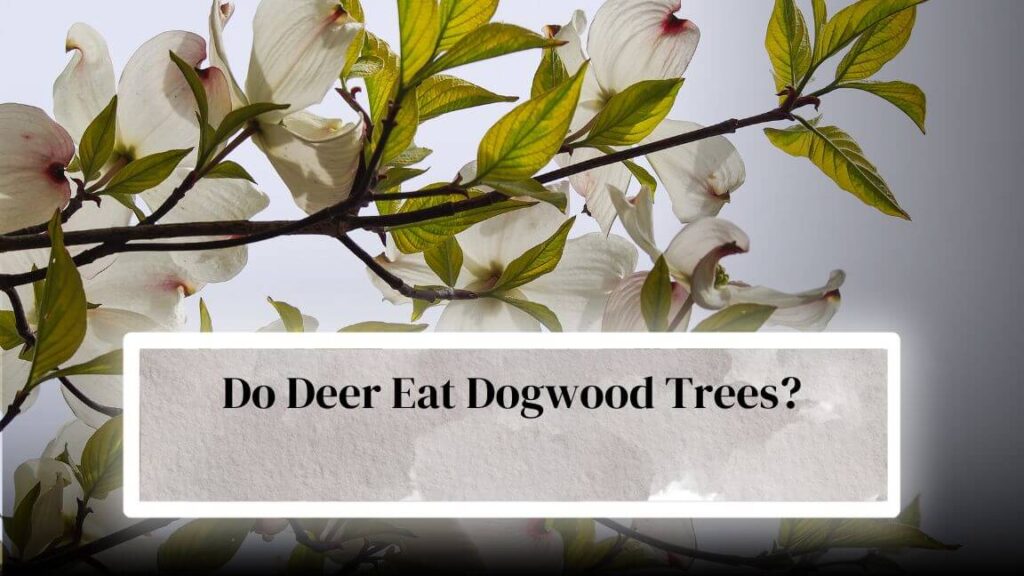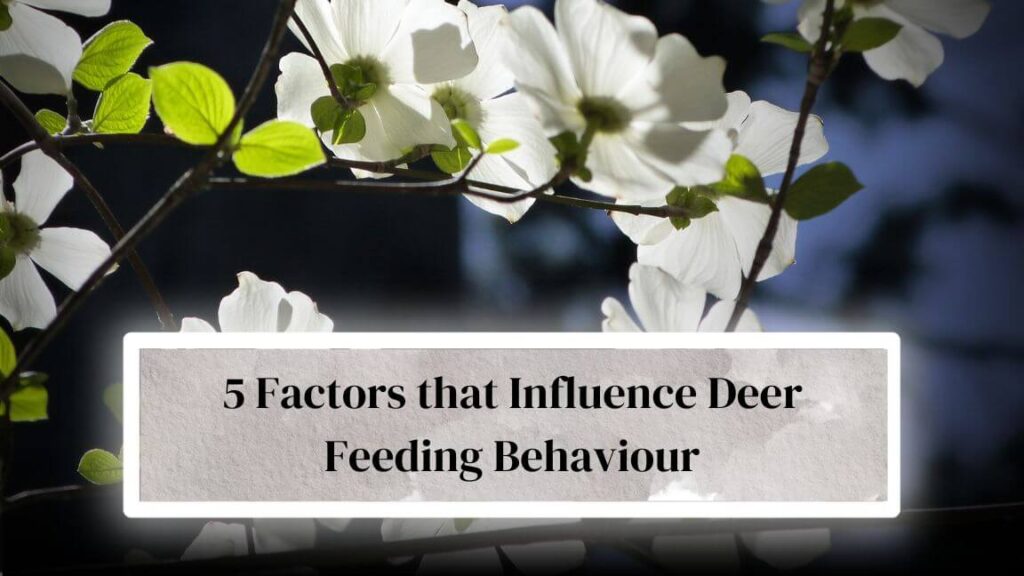
If you live in a region with fewer Deer, there is a problem. Before you ask, ‘Do deer eat dogwood trees,’ You should note that deers are herbivorous, and dogwood trees are like a food source.
We all know that Dogwood trees are popular in landscaping and gardens because of their attractive appearance & ability to provide year-round interest. Even though they are also beneficial for wildlife, like the flowers & berries provide food for birds & other animals, sometimes it becomes a problem.
In this article, I will answer questions like ‘Do deer eat dogwood bushes,’ ‘Do deer eat dogwood shrubs,’ ‘Are dogwood trees deer resistant,’ ‘Are dogwood bushes deer resistant,’ and ‘Are Are dogwood bushes deer resistant, ‘ and dogwood shrubs deer-resistant?
Let’s begin with the first question without wasting time, and then I will tell you ‘How To Protect Dogwood From Deer.’
Do Deer Eat Dogwood Trees?

Yes, they eat dogwood trees. A study conducted by the United States Department of Agriculture (.gov) claimed dogwood trees as one of the preferred food sources for white-tailed Deer.
Deer are herbivores, and they’ll have no hesitation in feeding dogwood trees material, including leaves, twigs, & fruit. If your trees are young, they’re more likely to be eaten by Deer because they prefer to eat plants high in protein & energy, like young shoots and tender leaves.
When food is scarce in winter, deers often start eating woody plants like shrubs & trees. Deer can cause significant damage to your dogwood trees, especially when populations are high in your region.
The study also revealed that Deer could strip the bark from the trunk & branches, causing permanent damage or death to your tree. If you don’t properly protect your trees, Deer will also eat the buds & flowers, reducing your tree’s ability to produce fruit.
Do Deer Eat Dogwood Berries?
Yes, Deer can eat dogwood berries. Note that Dogwood berries are an important food source for many wildlife species, including birds, squirrels, and of course, Deer. A study by the University of Minnesota found that Deer often eat fruit like dogwood berries when other food sources are scarce.
Also, if you have trees for berries, Deer can impact their production by consuming the fruit before it can mature. Trust me; this can significantly reduce the number of berries that should be available for other wildlife species. Who knows, Deer may also end up hampering your dogwood tree’s ability to reproduce.
Do Deer Eat Dogwood Shrubs?
As the University of Illinois, Say ‘ Deer prefer woody plants, like dogwood shrubs, over herbaceous plants because they contain more nutrients and are easier to digest. Not only on dogwood shrubs but Deer are known to feed on various plants.
However, it would help if you were extra cautious in the winter month because shrubs are considered a preferred food source for Deer when other food sources are scarce.
Ensure to provide proper cover and protection to plants and shrubs that are low to the ground, as they are easy and prime targets for Deer.
Believe me; you should provide proper protection because Deer can strip a dogwood shrub completely because of its buds and leaves, leaving it vulnerable to infestations and diseases.
Also, the Virginia corporate extension claims that deer damage can reduce the ornamental value of your tree by up to 50%.
If you don’t want to see Deer browsing your dogwood foliage & buds of the shrub, which may stunt its growth and reduce its overall health, consider installing proper fencing and physical barriers.
Shrubs like boxwood, holly, etc., are Deer resistant, but if you’re wondering if there is any dogwood variety deer resistant or ‘dogwood trees are Deer resistant, here is what you need to know.
Are Dogwood Trees Deer-Resistant?
No dogwood trees are not completely deer-resistant. However, deers may find some varieties less attractive than others. If you have the white Kousa dogwood, light protection from Deer should be fine.
Kousa Dogwood (Cornus kousa) is less likely to be browsed by Deer than the flowering dogwood (Cornus florida). If the deer population is high enough in your area, deer-resistant trees may also get damaged, particularly if they are hungry when the food is scarce.
As I told you, your young trees are more susceptible to damage by Deer than mature trees because of their tenderness and less ability to withstand browsing.
Are Dogwood Bushes Deer-Resistant?
Unfortunately, dogwood bushes are not known for their deer resistance. Dogwood bushes are said to be one of Deer’s most frequently browsed shrubs because they are typically low on land, easy to access, & quick to browse.
Are Dogwood Shrubs Deer-Resistant?
No, dogwood shrubs are not deer-resistant. Deer frequently browse all three types of dogwood shrubs; only some can repel them effectively with your help. There are many deer & wildlife repellents available online & offline that you can use to deter them.
Are Flowering Dogwood Trees Deer Resistant?
No, flowering dogwoods are not Deer resistant. Deer are more likely to browse the flowering dogwood variety than varieties like Kousa Dogwood.
However, deer browsing behavior depends solely on the tree variety or Species. A study conducted by researchers at Pennsylvania State University found that the presence of other vegetation nearby had a greater impact on deer browsing behavior than the tree species itself.
5 Factors that Influence Deer Feeding Behaviour

Time of Year
As I told you in the above section, deers attack Woody plants and trees when the food is scarce. In the fall and winter seasons, your dogwood trees are more vulnerable to deer browsing & damage.
During these seasons, you should be extra careful with the protection you provide to your trees. Also, make sure to provide proper protection from sudden temperature drops or cold drafts as well.
Even if dogwood trees are not their preferred food source, Deer are more likely to feed on dogwood trees if fewer food sources are available.
Availability of Food
Again, I will have to highlight this point. No one can deny that the availability of food for Deer also impacts their feeding behavior.
The dogwood trees produce tons of fruit in the fall season, making them more attractive to Deer during this time. For nutrition, Deer are likelier to turn to the dogwood trees in the fall when food sources are almost scarce.
Presence of Predators
Lastly, deer feeding behavior can also be influenced by the presence of predators. If Deer feel safe from Predators in a particular area, they’re likely to feed there in major cases. Similarly, Deer will always avoid locations or areas where predators are frequently sighted.
How To Protect Dogwood From Deer
When protecting your dogwood trees from Deer, it is important to use the right option and technique. You can do many things, like installing physical barriers, using repellents, landscaping techniques, and other methods to prevent Deer from damaging your prey and help them thrive.
Physical Barriers
Installing physical barriers is the most effective way to protect any tree from Deer and wildlife. If you are looking for this method, below are a few options.
Fencing
Since Deer are known to be excellent jumpers, you should get a fence at least 8 feet tall. Even though fencing is an effective way to keep all kinds of wildlife, including Deer, away from your trees, it is important to choose the right one. I prefer solid fencing, but if you prefer a more relaxed look, go with the wire fence with smaller holes.
Netting
Another great option for protecting your trees from Deer is netting which should be hung at least 6 feet above the ground & secured tightly to prevent Deer from getting through.
Tree Shelters
Lastly, you can use tree shelter as a physical barrier & protection from Deer. If you think tree Shelters are more complicated or expensive, they are not.
Tree Shelters are just plastic tubes that you place around young trees to protect them from Deer and wildlife. Make sure you choose the one that is tall enough to cover your entire tree and should be anchored securely to the ground.
Repellents
Another great way to temporarily keep Deer away from your trees is repellents. You can find many types of repellent, including chemical, natural and homemade. Here are a few options to go with.
Chemical Repellents
Chemical repellents are easily available online and offline and contain a scent or taste Deer finds unpleasant. You can spray these repellents on your tree bark and leaves to keep Deer away and protect your tree from damage. I usually like to go with products that contain natural ingredients like garlic, peppermint, or cinnamon.
Natural Repellents
Please use natural repellents than chemical ones because chemicals can damage the surrounding plant and even the tree on which you are using it if not done correctly.
If you think about what natural substances can be used as their Repellents, there are many, including human hair, soap, and blood meal. You can also hang these items around your trees to keep the Deer away.
Homemade Repellents
Lastly, You can make your own deer repellent rather than investing in one. This is more effective for people who are having difficulty finding the right repellent for their trees nearby or those who live in remote areas. I prefer making a homemade repellent for Deer by combining hot sauce, water, and dish soap.
Landscaping Techniques
Choosing Deer-Resistant Plants
You can find many plants that can be grown around the dogwood trees to keep the Deer away. You should visit the nursery and ask for deer-resistant plants, which are species that Deer don’t like to eat or be around.
If you can create a proper buffer zone using these species, you will successfully deter Deer from entering your yard or landscape. Some great examples of deer-resistant plants in your ornamental garden include daffodils, lavender, and yarrow.
Using Companion Planting
Professional gardeners always go with the plant species that can create mutually beneficial relationships by practicing companion planting. If you consider planting species that are less appealing to Deer, like garlic or onions, around your dogwood, it will act as a natural barrier to keep Deer away.
- Related Articles
- Red Twig Dogwood Companion Plants
- What To Plant With Ivory Halo Dogwood
Creating a Deer-Resistant Landscape
It may be time that you designed your landscape properly with deer-resistant plants and hardscaping elements that create visual barriers to deter Deer from entering your yard.
Your outdoor space can still look beautiful and functional while less attractive to Deer. If you want to know how this specimen looks in yards during fall, you should learn What Does A Dogwood Tree Look Like.
Other Methods
Lastly, there are a couple of other methods that you can use to keep Deer away, but I prefer a different way or the ones that I like to recommend or go with.
Scare Tactics
You can always use scare tactics to keep Deer away from your dogwood trees. You can do this by spraying any predator urine around your trees or using shiny objects like CD or Aluminium foil. You can also alternatively use motion-activated sprinklers.
Hunting and Culling
If hunting Deer is permitted and legal in your area, you can use culling and hunting methods to manage them around your particular location and reduce the likelihood of damage to your trees. However, this method is inhumane and not right.
Conclusion
As I told you, Deer not only attack dogwood trees, shrubs, bushes, berries, flowers, or their leaves but can also cause significant damage to them. This, You must provide proper protection to your trees. It becomes more important when the fall or winter approaches.
In the winter and all seasons, food sources will be very scarce for them, forcing them to eat woody plants, including dogwood trees and shrubs.
Out of all the methods I have discussed in this article to protect your dogwood tree from Deer, you should go with the physical barriers as they are more effective and last for a very long time.
If you find this article helpful, where I have shared useful information on protecting dogwood trees from Deer, please share this article. Your share will help many people grow l plant these trees in their gardens without worrying much about deer population or attacks.
I have also shared many other helpful dogwood tree care and management guides for you to check out on the website. See you in the next post, till then take care & goodbye.
